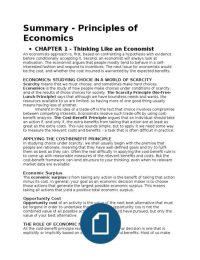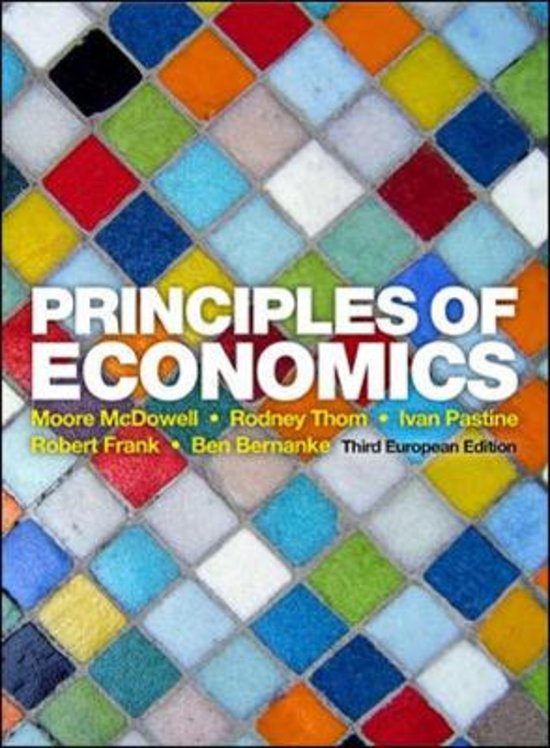Summary - Principles of
Economics
CHAPTER 1 - Thinking Like an Economist
An economists approach is, first, based on confronting a hypothesis with evidence
before conditionally accepting it. Second, an economist will always look at
motivation. The economist argues that people mostly tend to behave in a self-
interested fashion and respond to incentives. The next issue for economists would
be the cost, and whether the cost incurred is warranted by the expected benefits.
ECONOMICS: STUDYING CHOCIE IN A WORLD OF SCARCITY
Scarcity means that we must choose, and sometimes make hard choices.
Economics is the study of how people make choices under conditions of scarcity,
and of the results of those choices for society. The Scarcity Principle (No-Free-
Lunch Principle) says that although we have boundless needs and wants, the
resources available to us are limited, so having more of one good thing usually
means having less of another.
Inherent in the idea of a trade-off is the fact that choice involves compromise
between competing interests. Economists resolve such trade-offs by using cost-
benefit analysis. The Cost-Benefit Principle argues that an individual should take
an action if, and only if, the extra benefits from taking that action are at least as
great as the extra costs. This rule sounds simple, but to apply it we need some way
to measure the relevant costs and benefits – a task that is often difficult in practice.
APPLYING THE COST-BENEFIT PRINCIPLE
In studying choice under scarcity, we shall usually begin with the premise that
people are rationale, meaning that they have well-defined goals and try to fulfil
them as best as they can. Often the real difficulty in applying the cost-benefit rule is
to come up with reasonable measures of the relevant benefits and costs. But the
cost-benefit framework can lend structure to your thinking, even when no relevant
market data are available.
Economic Surplus
The economic surplus is from taking any action is the benefit of taking that action
minus its cost. In general, your goal as an economic decision maker is to choose
those actions that generate the largest possible economic surplus. This means
taking all actions that yield a positive total economic surplus.
Opportunity Cost
Opportunity cost of an activity is the value of the next best alternative that must
be forgone in order to undertake the activity. The opportunity cos is not the
combined value of all possible activities that you could have pursued, but only the
value of your best alternative.
THE ROLE OF ECONOMIC MODELS
All the cost-benefit principle really says is that a rational decision is one that is
explicitly or implicitly based on a weighing of costs and benefits. Most of us make
, sensible decisions most of the time, without being consciously aware that we are
weighing costs and benefits. Through trial and error, we gradually learn what kinds
of choices tend to work best in different contexts. The cost-benefit principle is an
abstract model of how an idealized rational individual would choose among
competing alternatives.
FOUR IMPORTANT DECISION PITFALLS
Knowing that rational people tend to compare costs and benefits enables
economists to predict the likely behavior of people in the aggregate. However, there
are some pitfalls of which you need to be aware in analyzing how rational choices
are made.
Pitfall 1: Measuring Costs and Benefits as Proportions Rather than
Absolute Money
You should measure costs and benefits in absolute money rather than in proportions.
It is, according to an economist, faulty reasoning to walk 30 minutes to save 10
euros on a 30 euro game, but not walk 30 minutes to save 10 euros on a 1000 euro
laptop. The cost and the benefit of walking to buy the laptop is exactly the same as
for the game, the economic surplus would also be the same. This means that a
rational decision maker would make the same decision in both cases. Yet, most
people choose to walk for the game and not walk for the laptop.
Pitfall 2: Ignoring Opportunity Costs
Many of us tend to overlook the implicit value of activities that fail to happen.
However, intelligent decisions require taking the value of forgone opportunities into
account. The opportunity cost of an activity is the value of the best alternative that
must be forgone in order to engage in that activity. Avoid overlooking opportunity
costs.
Pitfall 3: Failure to Ignore Sunk Costs
The only costs that should influence a decision about whether to take an action, are
those that we can avoid by not taking the action. However, many decision makers
appear to be influenced by sunk costs – costs that are beyond recovery at the
moment a decision is made. Because sunk costs must be borne whether or not an
action is taken, they are irrelevant to the decision of whether to take the action.
Pitfall 4: Failure to Understand the Average-Marginal Distinction
In many situations, the issue is not whether to pursue the activity at all, but rather
the extent to which it should be pursued. We can apply the Cost-Benefit Principle in
such situations by repeatedly asking the question ‘Should I increase the level at
which I am currently pursuing the activity?’ In attempting to answer this question,
the focus should always be on the benefit and cost of an addition unit of activity.
Economist refer to the cost of additional unit of activity as the marginal cost of the
activity. Similarly, the benefit of an additional unit of activity is the marginal
benefit of the activity. The cost-benefit framework emphasizes that the only
relevant costs and benefits in deciding whether to pursue an activity further are
marginal costs and benefits.







